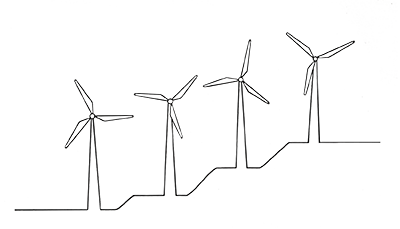Business Model Generation: Value proposition
Product Self-Service
Let your product automate its own operation and maintenance

How: Let products generate orders by themselves with the help of sensors and internet-enabled devices.
Why: Automate replenishment processes to generate recurring revenue and lock customers in.
Product Self-Service patterns have seen a surge in practical applications due to the proliferation of IoT-enabled devices and the discovery of novel uses for the sensors they employ. These patterns facilitate fully automated processes such as refilling, enabling customers to focus on their core activities while the mundane tasks are outsourced to the Self-Service object. Additionally, they create recurring revenue streams and lock customers into the property through the promise of uninterrupted material availability.
Applying the Product Self-Service business model
Product Self-Service patterns offer a value proposition that brings consumables and services together. By leveraging sensors and increasing computing power to draw the right conclusions, companies can eliminate material defects for the customer. For example, a heating system could automatically order oil refills once it falls below a certain level. This pattern is suitable for both B2B and B2C applications, with the increasing digitization of the environment providing the necessary network and sensor infrastructure.
Automation of Material Ordering
The utilization of sensors and IT infrastructure enables objects to independently generate orders, thus enabling fully automated processes such as refilling. This not only increases the speed of interaction with the object but also enables customers to concentrate on their core activities while time-consuming tasks are outsourced to the Self-Service object.
Optimizing the Network
Optimizing the network, either through active purchasing or regular on-site visits by the seller, leads to process improvements on both the demand and supply side. For instance, by replacing business models geared towards regular customer activities (e.g. office lunch delivery), the pattern reduces inventory and unnecessary transportation costs that potentially arise from the discrepancy between information asymmetry between the provider and end demand.
Predict, prevent, and auto-fix failures
As devices exchange bidirectional IoT data, consistent patterns begin to emerge. These patterns inform automated processes that can solve issues without any human involvement. When an automated event is received from an IoT device, the self-solve system analyzes the situation and triggers a response based on predefined rules and scenarios. This device-to-device communication can quickly address common fixes and alleviate the need for a call to the service center or a visit from a field service representative. However, if self-solve cannot resolve the issue, the system can always escalate it to a digital customer service channel or a human who can assist.
Reducing the risk of product or service failure is crucial, especially if the product or service is of critical value to the customer. For products or services that must always be on, predictive service models can be highly valuable. IoT connected-devices can collect large amounts of data to analyze for correlations. By augmenting these correlations with customer buying history and service records, businesses can effectively monitor and predict potential failures.
Incorporating Customer Service
When incorporating an IoT channel into customer service, businesses should consider their customers’ expectations of the product or service, as well as the value they want the product or service to have for the customer. Some businesses may be interested in a Self-Service model, while others are interested in a more engaging, high-touch assisted service model. Incremental investments enable businesses to learn, experiment, and evaluate the approach that works best for them and their customers.
Real life Product Self-Service examples
Smartbin
Its waste containers sense when they are full and communicate to a central platform, optimizing collection truck routes.
Volvo
Its cars can predict damage to gears and engines, cutting diagnostic times by 70% and repair times by 20% at authorised dealers.
Trigger Questions
- What will the dashboards and tools built on top of the smart devices help forecast and manage?
- How can you extend services to self-diagnose and aid problem solving?
Proven business models that have driven success for global leaders across industries. Rethink how your business can create, deliver, and capture value.
Get your deck!Related plays
- How IoT data enables automatic service and prevents product failures by Jeremy Kembel
- Object Self-Service by Karolin Frankenberger and Oliver Gassmann
- Waste Harmonics by Waste Harmonics
